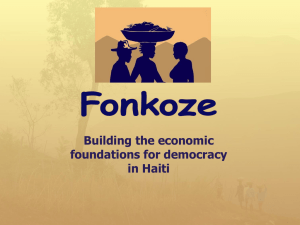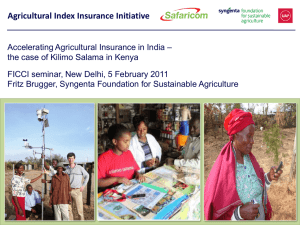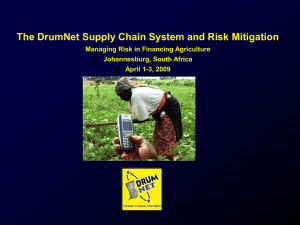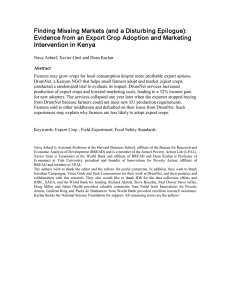EMW2010_Rausch - e-MFP
advertisement
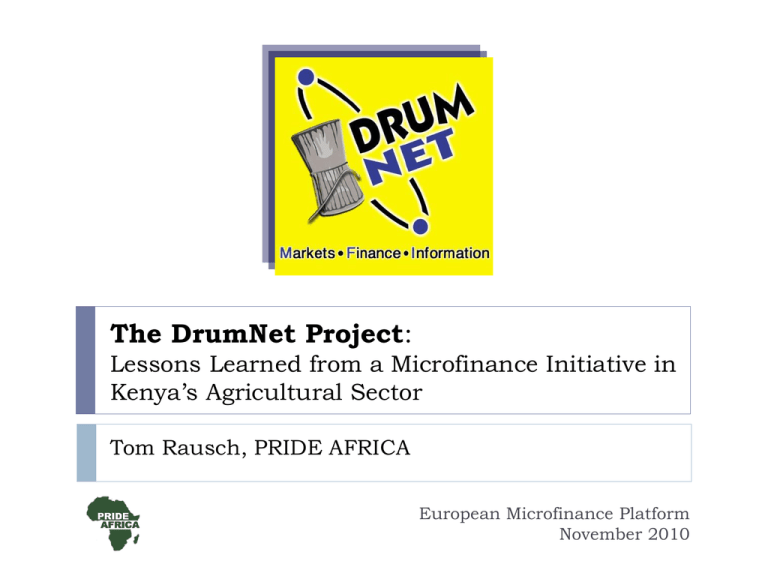
The DrumNet Project: Lessons Learned from a Microfinance Initiative in Kenya’s Agricultural Sector Tom Rausch, PRIDE AFRICA European Microfinance Platform November 2010 Agenda Background DrumNet in the Field Lessons Learned Lessons from a Microfinance Initiative in Kenya’s Agricultural Sector Microfinance and PRIDE AFRICA Background PRIDE established a microfinance model that scaled across several African countries, but model effective only in urban and peri-urban areas The PRIDE Network PRIDE created in 1988; one of the first to successfully utilize group solidarity microfinance approach in East/Southern Africa Model designed in Kenya, then replicated in Malawi, Tanzania, Uganda and Zambia; network now serves 250,000+ clients Traditional model inadequate when dealing with rural farmers facing long/risky crop cycles and poor group unity PRIDE focuses on agricultural sector in 2003 to achieve larger organizational impact and design microfinance approach for smallholder producers Source: PRIDE AFRICA Lessons from a Microfinance Initiative in Kenya’s Agricultural Sector What We Found… Background We found weak linkages between key actors in Kenya’s agricultural sector; made the design and deployment of mutually-beneficial financing products extremely difficult Banks Agro-Dealers Producers Buyers Rural Broker Urban Broker 1. Due to smallholders’ low productivity and geographic dispersion, most buyers choose to work through brokers. This reduces the price farmers receive for their produce. 2. Banks face high transaction costs and risk when trying to deliver financing products to poor, isolated farmers. Products either not right for farmers or not profitable for bank. 3. Agro-Dealers forced to take on input credit burden, so cannot provide other key services. 2. 3. Source: PRIDE AFRICA Lessons from a Microfinance Initiative in Kenya’s Agricultural Sector The DrumNet Project Background DrumNet introduced a platform that facilitated and incentivised cooperation between supply-chain partners, thus making producer financing increasingly feasible Banks Producers Buyers Agro-Dealers Source: PRIDE AFRICA Lessons from a Microfinance Initiative in Kenya’s Agricultural Sector The DrumNet Platform Background DrumNet’s Platform was two halves that made a whole; a rule-based business process made efficient by a central IT System Business Process End-to-end process with defined roles and responsibilities for supply-chain partners Created a standardized, predictable, ruleoriented environment in which partners could engage and complete transactions Registration & Training Planting & Scouting Contract & Loan Input Collection Harvest Produce Collection & Payment IT System Single unified database (Postgres) connected to a web-based portal (Java) Interactive with mobile phone technologies through SMS Gateway Enabled business process by reducing communication and transaction costs Source: PRIDE AFRICA Lessons from a Microfinance Initiative in Kenya’s Agricultural Sector Agenda Background DrumNet in the Field Lessons Learned Lessons from a Microfinance Initiative in Kenya’s Agricultural Sector DrumNet Operations In the Field After joining DrumNet, farmers gained access to a fixed purchase price contract from a large buyer; that contract, along with a TIF, secured a farm input loan from a bank 1 2 3 Recruitment and Registration Contract TIF and Loan 0254 0102 000032 Embu Farmers Group Source: PRIDE AFRICA Lessons from a Microfinance Initiative in Kenya’s Agricultural Sector DrumNet Operations (Continued) In the Field Partner agro-dealers alerted to farmers’ needs and farmers alerted via SMS when inputs available; farmers collect inputs using a cashless transaction process 5 4 Cashless Input Pick-up; Agro-dealer Paid Directly by Bank Bill of Materials and eToken Notification eToken: 368293 Seed:10kg DAP: 500kg Source: PRIDE AFRICA Lessons from a Microfinance Initiative in Kenya’s Agricultural Sector DrumNet Operations (Continued) In the Field Farmers plant and progress is tracked via SMS scouting; when farmers confirm crop is ready, they receive pick-up date and aggregate produce at agreed collection point 6 7 8 Cultivation and SMS Scouting Harvest Collection Point Pickup scheduled for 27 March 2010 Source: PRIDE AFRICA Lessons from a Microfinance Initiative in Kenya’s Agricultural Sector DrumNet Operations (Continued) In the Field Buyer takes title of produce at collection point; SMS verification process triggers payment invoice leading to repayment of bank loan and DrumNet/farmer payments 9 10 Invoicing and Payment Buyer Collection and Transaction Verification Bank Buyer has collected 7500kg seed Buyer Source: PRIDE AFRICA Lessons from a Microfinance Initiative in Kenya’s Agricultural Sector 1)Yes 2)No 3)Call Agenda Background DrumNet in the Field Lessons Learned Lessons from a Microfinance Initiative in Kenya’s Agricultural Sector Key Lessons: Market Demand Lessons Learned DrumNet was implemented across Kenya and provides a good basis to draw lessons; first is that demand for Ag finance services is high, but flexibility is also important DrumNet active in five Kenyan Provinces in collaboration with two large agro-buyers, a commercial bank, several agrodealers and 4,000+ farmers Facilitated several different supply-chains, including baby corn, French beans, passion fruit, sunflower and others As expected, farmers keen to join and take advantage of services; banks and agro-buyers also eager to get involved Also as expected, common request for larger loans to acquire irrigation equipment, storage facilities etc Less expected was that many farmers demanded smaller loans and, in some cases, no loan at all Source: PRIDE AFRICA Lessons from a Microfinance Initiative in Kenya’s Agricultural Sector Key Lessons: Loan Repayment Lessons Learned DrumNet saw improved repayment rates as the project progressed, but never hit its target; need for crop insurance apparent, questions about loan guarantee utilization Repayment rates increased as project advanced, from nearly complete default to better than 70% Increase largely due to improved production techniques, more flexible loan packages and better definition of rules/penalties But repayment rates never approached target of 90%; primary culprits included poor weather and side-selling Kenya hit by drought from ‘07 to ‘09, must bundle loans with crop insurance and procurement of irrigation technologies Side-selling brought on by the entrenchment of brokers, but also due to bank apathy because of partial loan guarantee Source: PRIDE AFRICA Lessons from a Microfinance Initiative in Kenya’s Agricultural Sector Key Lessons: Operating Environment Lessons Learned DrumNet started in 2003 and faced many operating environment challenges; issues remain, but noticeable movement towards friendlier rural microloan atmosphere Operations suffered from restrictive bank practices that forced farmers to travel great distances and DrumNet to submit an abundance of paperwork for each transaction Also legal issues, e.g. SMS not considered a legal document, leading to dramatic payment delays, etc. However, with the introduction of Agency Banking, as well as innovative banking products like M-Kesho and Iko Pesa, rural, smallholder lending is becoming more practical in Kenya Also have progress in policy space and technology infrastructure that improve the timeliness and reduce the cost of financial transactions Source: PRIDE AFRICA Lessons from a Microfinance Initiative in Kenya’s Agricultural Sector Parting Thoughts Lessons Learned DrumNet operated as a research project, but has the potential to run as a profitable service provider; this increasingly the case given Kenya’s current trajectory Market Capacity Environment Demand for financial services is rife among key agricultural players and the local environment is increasingly accommodating With the integration of technology and other essential products, high repayment rates can be achieved without astronomical time/monetary costs The (large) missing piece is the build of a more professional software that can handle volume and reduce the need for extensive human input Source: PRIDE AFRICA Lessons from a Microfinance Initiative in Kenya’s Agricultural Sector Thank You Lessons from a Microfinance Initiative in Kenya’s Agricultural Sector



